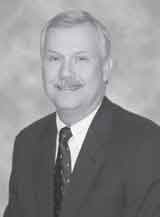From the Executive Director
Shift happens

Right up front I have to admit that the phrase “Shift happens” is not an original thought arising from me. I borrowed it from an interesting video passed on to me by my wife. She works in education, and this video entitled “Did You Know 2.0” presents information on the changes in the world and the impact they may have on education. Some of the changes, such as globalization and technology advancements, are mind boggling. If you are interested, this video and others like it can be accessed on YouTube at http://www.youtube.com/watch?v=pMcfrLYDm2U.
Change occurs in most, if not all, industries. Shift happens that may be expected or unexpected. Shift to which you paid attention or did not pay attention. Shift that may or may not impact your professional life. Shift that is internal or external in nature. Not only is the shift itself important, but also how you react and adjust to the shift. Whether you call it change or shift, it also happens in veterinary medicine and pork production.
There are many examples of the shifts we have each seen happen in our professional lives as swine veterinarians. Some are related to the business of pork production. Most of us recall the price debacle seen in 1998 and 1999. Today those who persisted in raising pigs have enjoyed a remarkable run of profitable years. The future of ethanol production may bring yet another significant shift.
Other shifts are related to the practice of veterinary medicine. The eradication of pseudorabies has altered the daily life of many practitioners. No longer are we spending time bleeding large numbers of pigs for this disease. Surveillance and exclusion now become the desired activities. Soon pseudorabies will be classified as a foreign animal disease for the United States. That shift will have its own impact on how private practitioners and regulators react to potential outbreaks.
Other shifts are related to disease. Depending on our generation, we can each name a disease that had a particular impact on our patients and clients. Hog cholera (classical swine fever), TGE, swine dysentery, and parvovirus were all diseases of great interest over the years at the AASV annual meeting. For me, PRRS comes to mind as a shift that happened in swine veterinary medicine. With PRRS came the early uncertainties over diagnosis and treatment. More recently, these concerns have shifted somewhat into frustration over keeping PRRS out of clean herds. Can you imagine the shift that will happen if PRRS is eradicated?
Consider your life before porcine circovirus associated disease reared its ugly head. Think of what changed by its appearance in your clients’ herds. Has it made you reconsider your thoughts on high-mortality disease prevention, treatment, and control? On how you view biosecurity? Sick-pig management? What about diagnosis? How do we anticipate the next big disease? Perhaps, more importantly, how do we prevent the next high-mortality disease or better prepare for its arrival?
Some shifts are external to pork production, but have an impact nonetheless. The growing controversy over the use of gestation stalls is inching its way into everyday decisions on how we manage pigs. The animal rights activists are raising the issue through state legislation and ballot initiatives. The affluence and ignorance of the public are allowing the activists to gain momentum. This is happening despite the fact that the best science tells us that neither stalls nor pens have a clear and distinct advantage over the other. Little good will ultimately come from forced prohibitions of a production practice. A better solution is to let the consuming public decide by voting with their purchases. If stall-free production is desired, then some willing entrepreneur could certainly strike it rich by offering a branded product. A market-driven shift would certainly be more palatable than one forced by an animal rights or vegetarian agenda.
So shift happens! Over the years, these shifts have certainly influenced AASV programming at our annual meeting. They have compelled researchers to publish in the Journal of Swine Health and Production. They have motivated the publishing of educational materials. They have even influenced members to run for AASV officer and director positions.
Shift will continue to happen. What is AASV going to do about it? Respond once shift happens? If AASV is to be of greater value to its members, then it must be able to serve an “early-warning” function to warn and prepare members for the shift. Active monitoring of both external and internal factors can provide insight to shifts before they occur. It would be very desirable to foster the ability to forecast the probability of a shift happening and the importance of the shift to AASV members. The AASV must gather data from its members and other sources in order to be able to efficiently and effectively use its resources to increase the knowledge of swine veterinarians in response to shift.
Not all shifts can be anticipated. There is a quote from the “Did You Know 2.0” video that is challenging for any organization involved in education: “We are currently preparing students for jobs and technologies that don’t yet exist….. in order to solve problems we don’t even know are problems yet.” In light of this challenge, AASV can still do better to prepare its members through education and by creating a framework of knowledge and problem-solving skills that can be applied as new problems arise.
I am fairly certain that Albert Einstein was not thinking of swine veterinary medicine when he said “We can’t solve problems by using the same kind of thinking we used when we created them.” However, I am confidant that his statement is very applicable to what we do as veterinarians in the swine industry. Shift happens. How we view the shift, how we react to the shift, and how we prepare for the next shift will all have implications for how successful we will be in the future.
-- Tom Burkgren
